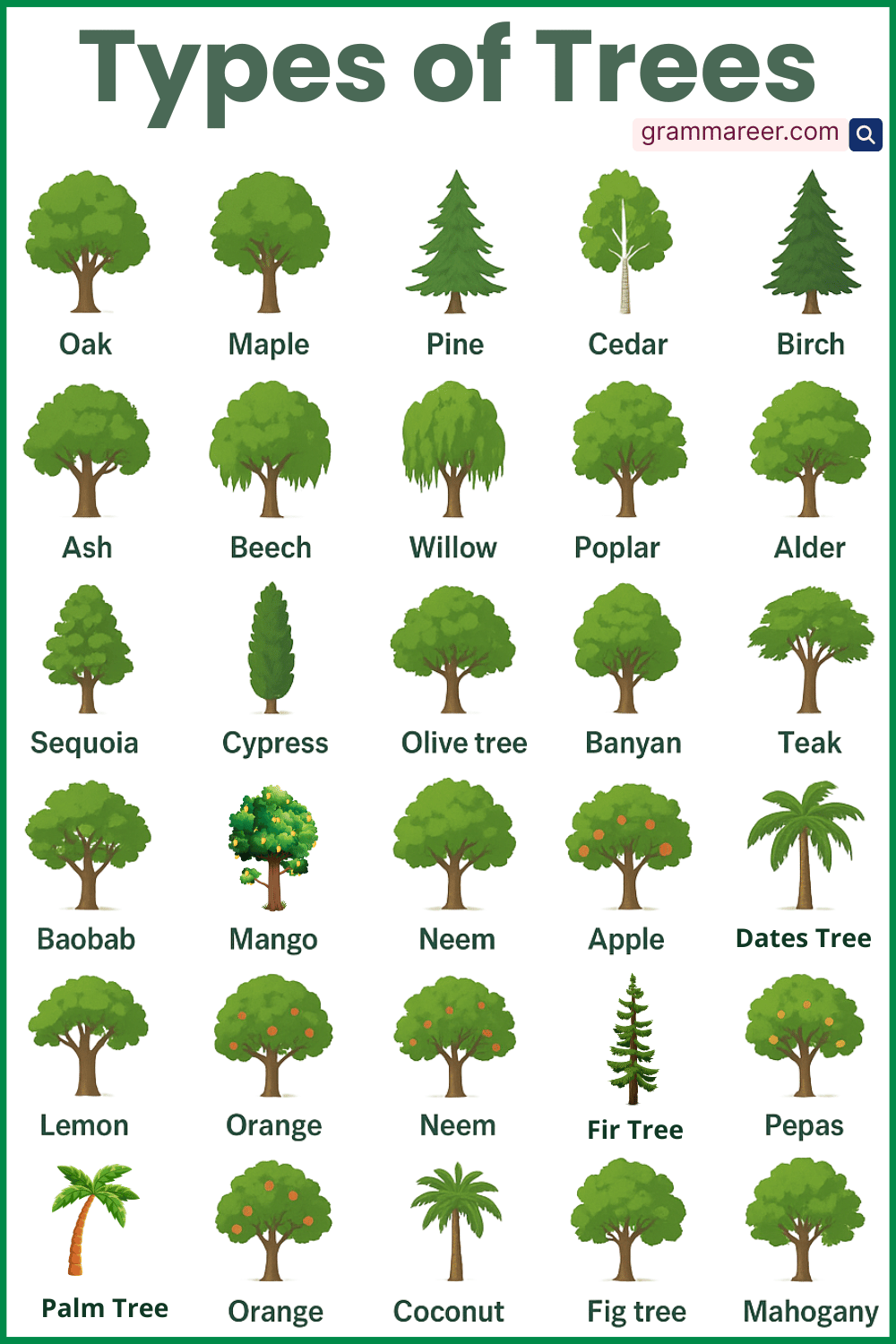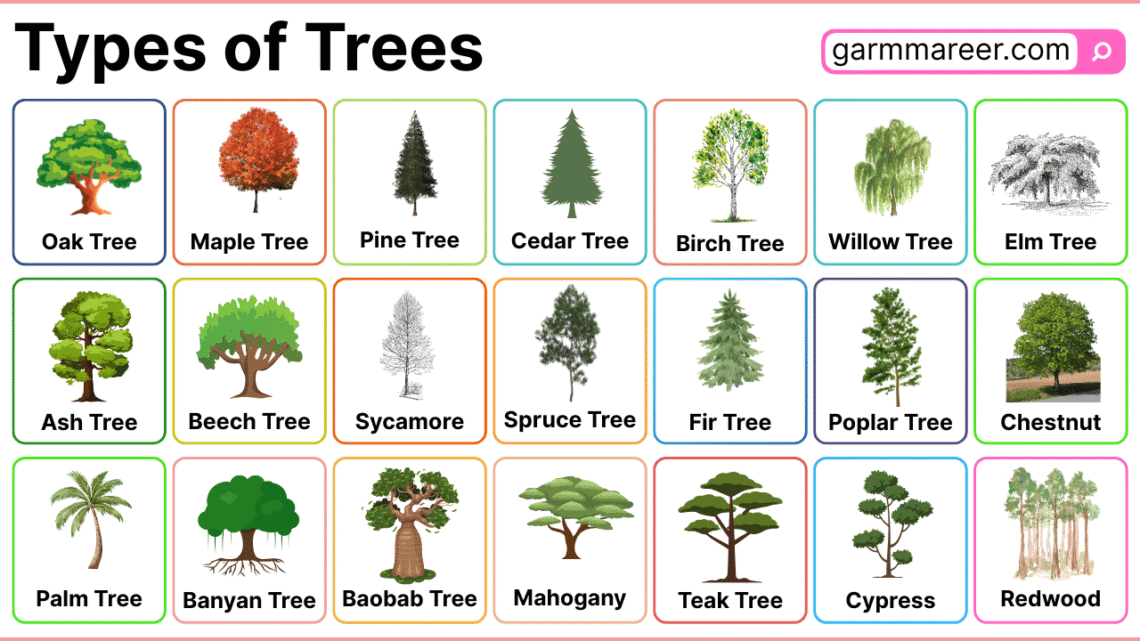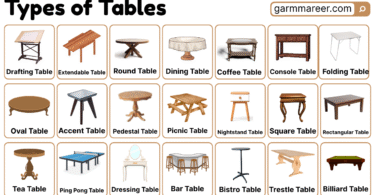Learning the types of trees helps you recognize different species by their unique features, shapes, and natural categories. Each tree has its own structure, and knowing their names helps in understanding how they connect to the environment and their usage in human life.
This blog post will help you learn tree names in English with pictures, grouped into easy sections like evergreen, deciduous, desert, and fruit trees. Knowing these names makes it easier to talk about them in school, gardening, biology, and even daily conversations.
Table of Contents
Types of Trees with Uses and Facts and Pictures
Tree names give us a simple way to understand nature’s variety. They are often grouped by their growth style and the environments where they thrive. Below is a list of common tree names in English that can be learned with their pictures.
- Oak Tree: Strong hardwood tree, known for shade, strength, and long-lasting timber.
- Ash Tree: Tall straight tree, often used in tools, sports goods, and furniture.
- Palm Tree: Tropical tree with long leaves, famous for coconuts, dates, and beach landscapes.
- Maple Tree: Broadleaf tree with colorful leaves and sweet sap used for maple syrup.
- Beech Tree: Smooth-barked tree producing nuts, shade, and oxygen in forest habitats.
- Banyan Tree: Massive spreading tree with aerial roots, symbol of shelter and wisdom.
- Pine Tree: Evergreen tree with cones, valued for wood, resin, and Christmas traditions.
- Sycamore: Large shade tree with mottled bark, commonly planted in urban landscapes.
- Baobab Tree: African tree of life, storing water and offering fruit, bark, and shelter.
- Cedar Tree: Aromatic evergreen tree, resistant to decay, widely used in construction.
- Spruce Tree: Tall northern evergreen tree, producing cones and timber for paper.
- Mahogany: Tropical hardwood tree, valued for reddish timber in premium furniture.
- Birch Tree: White-barked tree, graceful and common in cool, moist forests.
- Fir Tree: Evergreen tree, widely recognized as the traditional Christmas tree.
- Teak Tree: Tropical hardwood tree, producing strong timber for outdoor furniture.
- Willow Tree: Tree with drooping branches, thriving near rivers, lakes, and wetlands.
- Poplar Tree: Fast-growing tree, tall and straight, useful for paper and plywood.
- Cypress: Slender evergreen tree, symbolic of immortality and strength in cultures.
- Elm Tree: Tall broad-crowned tree, once common along city avenues.
- Chestnut: Nut-bearing tree, offering shade, strong timber, and edible chestnuts.
- Redwood: World’s tallest tree species, native to California’s ancient forests.

List of Trees Names
Here is a table of tree names in English arranged in four columns for better clarity.
| Ash | Cedar | Birch | Palm |
| Oak | Pine | Maple | Willow |
| Elm | Fir | Spruce | Olive |
| Teak | Banyan | Mango | Neem |
| Mahogany | Sycamore | Walnut | Poplar |
| Beech | Redwood | Acacia | Chestnut |
| Eucalyptus | Hazel | Cypress | Baobab |
| Date Palm | Dogwood | Alder | Juniper |
Different Types of Trees With Names
Trees are divided into different categories depending on how they grow and adapt to weather. The following sections cover evergreen, deciduous, and desert types with their names.
Evergreen Trees
Evergreen trees remain green throughout the year and keep their leaves even in cold months. Some well-known evergreen trees include:
- Pine
- Cedar
- Spruce
- Fir
- Cypress
- Olive
- Eucalyptus
- Juniper
- Holly
- Laurel
- Hemlock
- Magnolia
- Redwood
- Teak
- Mahogany
Deciduous Trees
Deciduous trees shed their leaves every autumn and grow fresh leaves in spring. Many common shade and fruit trees fall under this category. Some names are:
- Oak
- Maple
- Ash
- Elm
- Birch
- Willow
- Poplar
- Sycamore
- Beech
- Chestnut
- Walnut
- Alder
- Dogwood
- Hickory
- Aspen
Desert Trees
Desert trees adapt to dry, hot climates and store water in their roots, stems, or leaves. Here are some well-known desert trees:
- Acacia
- Mesquite
- Palo Verde
- Joshua Tree
- Date Palm
- Ironwood
- Desert Willow
- Ocotillo
- Baobab
- Smoke Tree
- Gum Arabic Tree
- Moringa
- Desert Ironwood
- Salt Cedar
- Screwbean Mesquite
Trees Grown for Wood and Timber
Some trees are grown mainly for strong wood, which is used in furniture, building, and tools.
- Teak Trees: Known for their durable and water-resistant wood, teak is often used in furniture and shipbuilding.
- Oak Trees: Oak wood is strong and heavy, often used for flooring, furniture, and barrels.
- Mahogany Trees: Mahogany has reddish-brown wood, valued for luxury furniture and decorative purposes.
- Pine Trees: Pine wood is soft and light, commonly used for construction, paper, and carpentry.
- Cedar Trees: Cedar wood has a pleasant smell and natural oils, making it resistant to insects and decay.
Common Types of Fruit Trees
Fruit trees are an important group of trees because they provide food along with shade and beauty. Some common fruit tree names include:
- Mango Tree: Tropical tree producing sweet, juicy mangoes, widely grown in warm climates.
- Apple Tree: Deciduous tree bearing crisp apples, popular for eating fresh or cooking.
- Orange Tree: Evergreen citrus tree producing juicy oranges, rich in vitamin C.
- Banana Tree: Large tropical plant yielding bananas, a staple fruit in many countries.
- Pear Tree: Fruit-bearing tree producing pears, sweet and soft with juicy texture.
- Plum Tree: Small tree yielding plums, eaten fresh, dried, or made into jam.
- Cherry Tree: Flowering tree producing cherries, loved for fruit and spring blossoms.
- Peach Tree: Deciduous tree producing peaches with fuzzy skin and sweet flavor.
- Lemon Tree: Citrus tree producing sour lemons, widely used in drinks and cooking.
- Fig Tree: Ancient fruit tree yielding figs, eaten fresh, dried, or in desserts.
- Guava Tree: Tropical tree producing guavas, rich in vitamin C and fiber.
- Olive Tree: Evergreen Mediterranean tree yielding olives, used for oil and pickling.
- Papaya Tree: Fast-growing tropical tree producing papayas, soft fruits rich in enzymes.
- Pomegranate Tree: Hardy tree yielding pomegranates, full of juicy red arils and antioxidants.
- Coconut Tree: Tall palm tree producing coconuts, valued for water, milk, and oil.
- Date Palm Tree: Desert palm tree yielding dates, rich in natural sugars and fiber.
- Apricot Tree: Small deciduous tree producing apricots, sweet fruits eaten fresh or dried.
- Grapefruit Tree: Citrus tree bearing grapefruits, tangy fruits rich in vitamin C.
- Lychee Tree: Tropical evergreen tree producing lychees, juicy fruits with floral sweetness.
- Mulberry Tree: Fast-growing tree producing mulberries, sweet berries eaten fresh or dried.
Endangered and Rare Trees Features by Region
| Tree Name | Region/Origin | Notable Feature / Reason for Rarity |
|---|---|---|
| Baobab Tree | Africa | Iconic tree, threatened by climate change |
| Dragon Blood Tree | Socotra (Yemen) | Produces red resin, highly vulnerable |
| Frankincense Tree | Arabian Peninsula, Africa | Source of resin, declining due to overharvesting |
| Monkey Puzzle Tree | Chile, Argentina | Rare conifer, legally protected |
| Bois Dentelle Tree | Mauritius | Extremely rare, only a few left |
| Magnolia stellata | Japan | Rare magnolia, limited in wild habitats |
| African Blackwood | East Africa | Valued for instruments, overexploited |
| Kauri Tree | New Zealand | Ancient tree, threatened by root disease |
| Alerce Tree | Chile, Argentina | Long-living, endangered by logging |
| Hainan Yellowwood | China | Critically endangered, very few remain |
| Camphor Tree | Asia | Rare in natural forests due to deforestation |
| Wollemi Pine | Australia | Ancient species, rediscovered 1994 |
| Rosewood Trees | Tropical regions | Overharvested for luxury furniture |
| Loulu Palm | Hawaii | Many species critically endangered |
| Whitebark Pine | North America | Threatened by pests and climate change |
| Red Sandalwood | India | Endangered due to fragrant wood trade |
| Oshawa Hemlock | North America | Rare hemlock species, declining |
| Indian Kino Tree | India | Valued for timber/medicine, now rare |
| Chilean Wine Palm | Chile | Endangered by sap harvesting |
| Yangtze Paraffin Tree | China | Critically endangered, very limited range |
FAQs about Types of Trees
The main types of trees are evergreen, deciduous, desert, and fruit trees, based on their growth and conditions.
The oak tree is often called the king of trees because of its strength and wide use.
The oldest tree is a bristlecone pine in California, estimated to be over 4,800 years old.
Peepal tree and oak tree are known to give high amounts of oxygen compared to many others.
Evergreen trees keep their leaves all year, while deciduous trees shed their leaves in autumn.
You May Also Like




